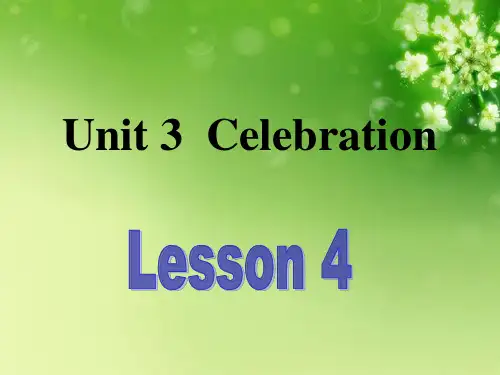北京市房山区周口店中学高中英语《Unit 3 Celebration-Lesson 1》课件 北师大
- 格式:ppt
- 大小:2.25 MB
- 文档页数:17
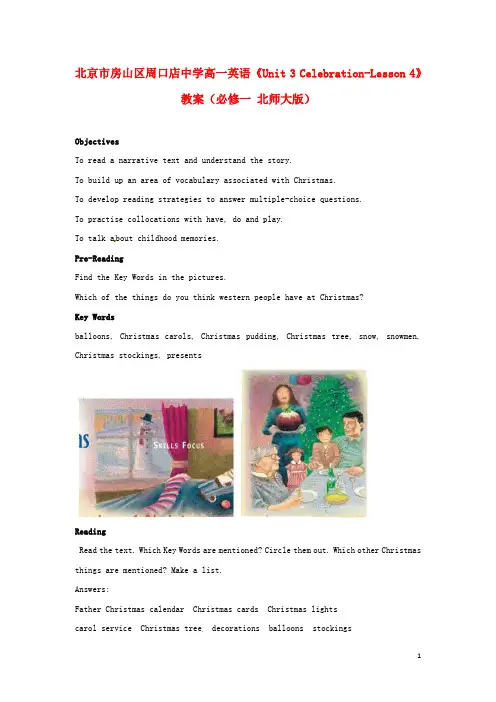
北京市房山区周口店中学高一英语《Unit 3 Celebration-Lesson 4》教案(必修一北师大版)ObjectivesTo read a narrative text and understand the story.To build up an area of vocabulary associated with Christmas.To develop reading strategies to answer multiple-choice questions.To practise collocations with have, do and play.To talk a bout childhood memories.Pre-ReadingFind the Key Words in the pictures.Which of the things do you think western people have at Christmas?Key Wordsballoons, Christmas carols, Christmas pudding, Christmas tree, snow, snowmen, Christmas stockings, presentsReadingRead the text. Which Key Words are mentioned? Circle them out. Which other Christmas things are mentioned? Make a list.Answers:Father Christmas calendar Christmas cards Christmas lightscarol service Christmas tree decorations balloons stockingspresents sweets turkey Christmas pudding paper hats Queen’s speech Christmas cakeWhat’s t he main idea of each paragraph?Para. 1 the beginnin g of ChristmasPara. 2 decor ations outsidePara. 3 activities on Christmas EvePara. 4 activities on Christmas morningPara.5 activities after lunchPost- ReadingIn what order did the children do these things?Example 1 da)open the new year calendarb)put their stockings at the end of the bedChristmas tree Father Christmas carol service candle snowman decorationspresents turkeyChristmas stockingssweetsChristmas cakec)sing Ch ristmas carolsd)write a let ter to Father Christmase)put up the Christmas treef)go to churchg)have Christmas cakeAnswers: 2 a 3c 4e 5b 6f 7gAnswer the multiple-choice questions.1 Who d o you think reads the children’s letters?a) Father Christmas b) their parents c) nobody2 What do you think people do in a carol service?a) sing songs b) give presents c) watch a play3 What happened on Christmas Eve?a) The writer stayed awake all night.b) Someone put presents in his stocking.c) The writer saw Father Christmas.4 Why did they laugh?a) The Christmas carols were happy songs.b) The songs and hats were funny.c) The jokes and hats were funny.5 After lunch:a) the adults watched the Que en’s speech.b) the children made a snowman.c) everybody had more to eat.Answers: 1b 2a 3b 4c 5cVocabularyIn English, some verbs and nouns often go together. Complete the table with these words:tea, the piano, your homework, a shower, cards, a (snowball) fight, a party, the washing-up, lunch, the shoppinghave do playtea, a showera (snowball) fight, a party, lunch your homework,the washin g-up, theshoppingThe piano, cardsComplete the sentences with these verbs in the correct form.blow up, sing, go to, put up, have(x2), make, put onOn Christmas Eve, my grandparents arrived. We(1) a snowman in the garden and later we (2) the decoration. I (3) lots of balloons. On Christmas morning, I (4) some warm clothes and (5) a snowball fight with my cous insa nd then we(6) church. After that, we(7) lunch and(8) Christmas carols.Answers1 made2 put up3 blew up4 put on5 had6 went to7 had8 sangWriting and SpeakingMake notes about your childhood memories of an important festival.People: family? Good friends?Preparations: decorations? Invitations?Presents: what? Who for? Make/buy?Food: meals? Special food/drink?Activities: music? Dancing? A long walk?Your feelings: happy? Sad?。
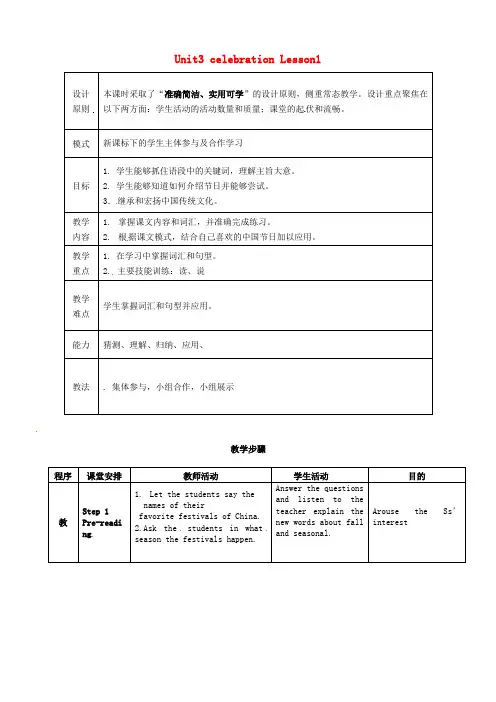
Unit3 celebration Lesson1设计原则本课时采取了“准确简洁、实用可学”的设计原则,侧重常态教学。
设计重点聚焦在以下两方面:学生活动的活动数量和质量;课堂的起伏和流畅。
模式新课标下的学生主体参与及合作学习目标1. 学生能够抓住语段中的关键词,理解主旨大意。
2. 学生能够知道如何介绍节日并能够尝试。
3.继承和宏扬中国传统文化。
教学内容1.掌握课文内容和词汇,并准确完成练习。
2.根据课文模式,结合自己喜欢的中国节日加以应用。
教学重点1. 在学习中掌握词汇和句型。
2.主要技能训练:读、说教学难点学生掌握词汇和句型并应用。
能力猜测、理解、归纳、应用、教法. 集体参与,小组合作,小组展示教学步骤程序课堂安排教师活动学生活动目的教Step 1Pre-reading1.Let the students say thenames of theirfavorite festivals of China.2.Ask the students in whatseason the festivals happen.Answer the questionsand listen to theteacher explain thenew words about falland seasonal.Arouse the Ss’interestStep 2 Reading 1.Read the text quickly andmatch the pictures with thefestivals2.Try to say out some key wordsof each passage, if theycan’t, teacher will givethe example, such as: theMid-autumn Festival,September or October, mooncakes3.Read the passages again,then fill in the blanks.4.check the answers1.Silent reading,skimming2.Discussion andget the answer3.Show the answeron the screen1. Get the gener alidea of each passa ge2. Get the details andlearn each otherStep 3:Post reading 1.Tell the students how todescribe a festival2.Let the students talk aboutSpring Festival3.Show the result.1. Do the exercise inclass2. DiscussionShow their result1. Learn thevocabulary in thetest2. Use and enlarge theknowledge of festivalStep 4 Home- work 1. Reading paper2. Finish the Ex P79 5。
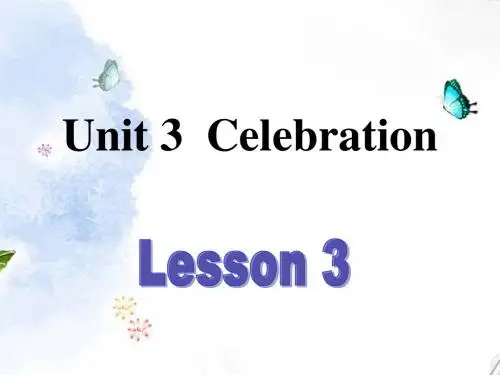
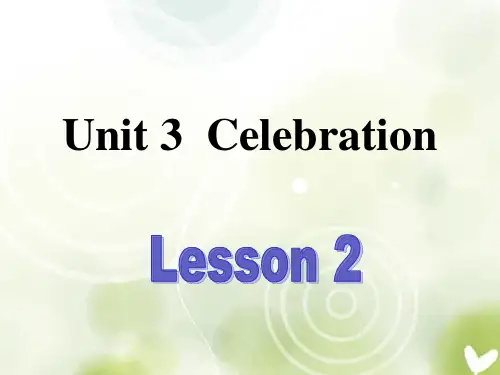
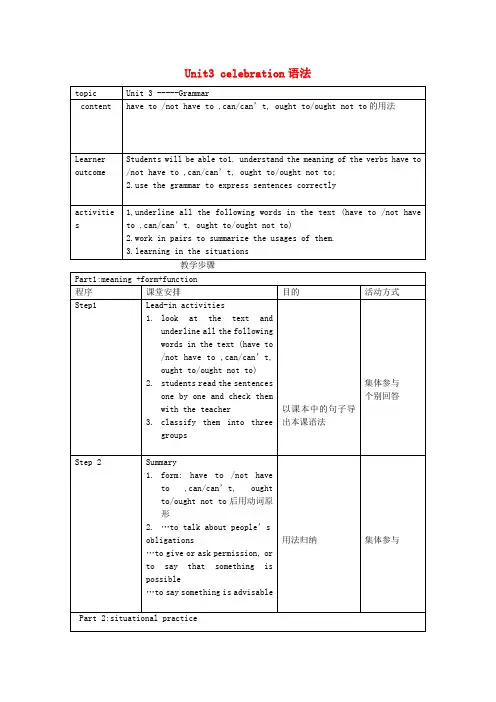
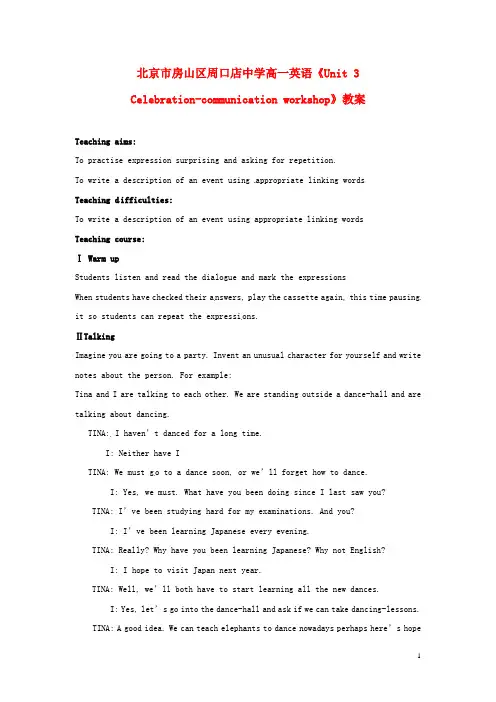
北京市房山区周口店中学高一英语《Unit 3Celebration-communication workshop》教案Teaching aims:To practise expression surprising and asking for repetition.To write a description of an event using appropriate linking wordsTeaching d ifficulties:To write a description of an event using appropriate linking wordsTeaching course:Ⅰ Warm upStudents listen and read the dialogue and mark the expressionsWhen students have checked their a nswers, play the cassette again, this time pausingit so students can repeat the expressi ons.ⅡTalkingImagine you are going to a party. Invent an unusual character for yourself and write notes about the person. For example:Tina and I are talking to each other. We are standing outside a dance-hall and are talking about dancing.TINA: I haven’t danced for a long time.I: Neither have ITINA: We must g o to a dance soon, or we’ll forget how to dance.I: Yes, we must. What have you been doing since I last saw you?TINA: I’ve been studying hard for my examinations. An d you?I: I’ve been learning Japanese every evening.TINA: Really? Why have you been learning Japanese? Why not English?I: I hope to visit Japan next year.TINA: Well, we’ll both have to start learning all the new dances.I: Yes, l et’s go into the dance-hall and ask if we can take dancing-lessons.TINA: A good idea. We can teach elephants to dance nowadays perhaps here’s hopefor us.Ask students to make up a dialogue according to it.Tom Jackson and Charles Brown are talking about their summer holidays at party. Tom: Where are you going for your holidays, Charles?Charles: To Australia. I’m going to visit my uncle in Brisbane for three weeks. Tom: Oh wonderful! You certainly are lucky. How are you going there? Charles: By air, of course. It takes over two weeks to go by sea.Tom: I once went to Singapore by air. It was very exciting- but never again. Charles: Why? Did you feel frightened?Tom: For a short time. One of the engines caught fire.Charles: Too terrible! What did the pilot do?Tom: He put it out and flew back to the airport. Then he asked the people at the airport where the emergency runway was.Charles: Did you land safely?Tom: Yes, we did. But I shall never fly again.Ⅲ H ow to writeWe must know how we should writ e an event, that is to say , knowing what we write first , then wha t happened , finally ho w it end. So let’s read t he description of the party. Then judge these topics with the paragraph.Ⅳ Further studyi ngTurn to page 91, read the article to study the structure of an article.。
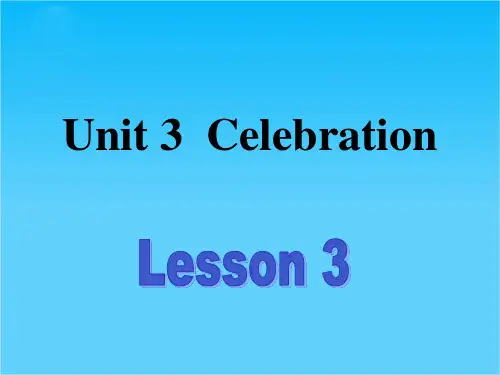
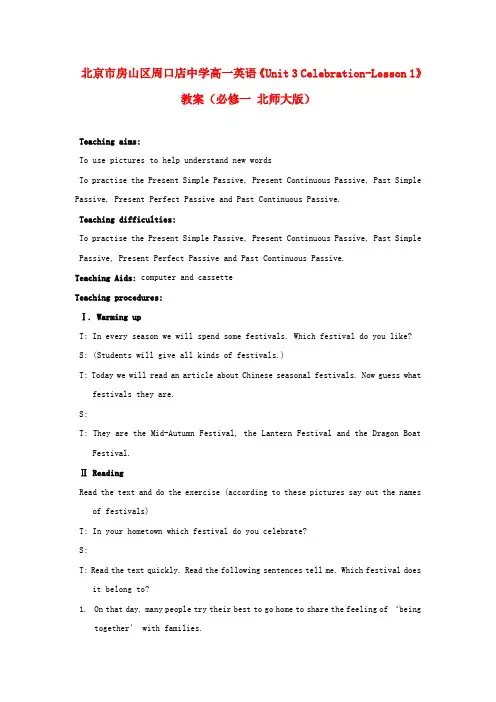
北京市房山区周口店中学高一英语《Unit 3 Celebration-Lesson 1》教案(必修一北师大版)Teaching aims:To use pictures to help understand new wordsTo practise the Present Simple Passive, Present Continuous Passive, Past Simple Passive, Present Perfect Passive and Past Continuous Passive.Teaching difficulties:To practise the Present Simple Passive, Present Continuous Passive, Past Simple Passive, Present Perfect Passive and Past Continuous Passive.Teaching Aids: computer and cassetteTeaching procedures:Ⅰ. Warming upT:In every season we will spend some festivals. Which festival do you like? S: (Students will give all kinds of festivals.)T: Today we will read an article about Chinese seasonal festivals. Now guess what festivals they are.S:T: They are the Mid-Autumn Festival, the Lantern Festival and the Dragon Boat Festival.Ⅱ ReadingRead the text and do the exercise (according to these pictures say out the names of festivals)T: In your hometown which festival do you celebrate?S:T: Read the text quickly. Read the following sentences tell me. Which festival does it belong to?1.On that day, many people try their best to go home to share the feeling of ‘beingtogether’ with families.2. This festival marks the end of the Chinese New Year celebration.3. This festival marks the beginning of the hottest season of the year.4. The special food for the day is sweet dumplings.5. The festival falls on the fifth day of the fifth month of the lunar calendar.6. On that night, the moon is said to be the biggest and the brightest. Answers: 1.the Mid-Autumn Festival 2.the Lantern Festival 3. the Dragon Boat Festival 4. the Lantern Festival 5. the Dragon Boat Festival 6.the Mid-Autumn FestivalⅢ Talking and speakingDivide the class into three groups. Each group reads one section of the text carefully and writes four or five questions about it. Then give the class three or four minutes to read the whole text again. Students close their books to ask questions for the rest of the class to answer.Do the exercise 3Encourage students to describe other festivals they know well but they can’t tell the name of the festival so that other students will be interested to guess what they are.Ⅳ Voice your opinion1. In western countries which festivals do people celebrate? Can you describe them to your students? Are the festivals between China and western countries similar or different?2. Do you think too much money is spent at festival times? Why or why not?3. Which festival in china is most important for children, young people, old people,women or men?Ⅴ GrammarShow students the basic passive structureCompare a sentence of the active voice with one of the passive voice.Do the exercise 5, 6, 7 and 8Ⅵ VocabularyDo the exercise 9Ⅶ HomeworkDo the exercise 10。
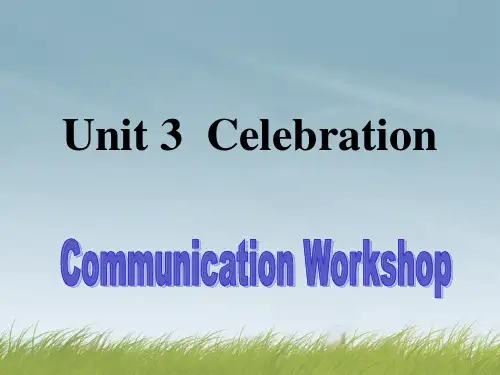
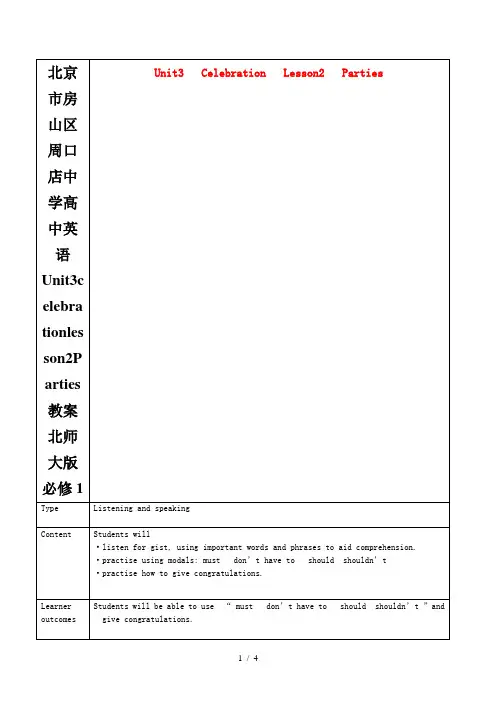
ImportantpointsExpressions of giving advice and congratulationsDifficultpointsStudents may confuse the meaning of “must should don’t have to shouldn’t ”.ResourceusedCassette computerSteps Teacher’s activities Students’ activities Teaching purposeStep1 Warming upShow 4 photos and ask “what kind of parties are they? What is happening atthese parties?Look at the photos,think and answer to thequestions.(group work)Lead into thetopic, arouse thestudents’interest.Step2 Pre-listeningsome new words on the computerand let the stud ents learn and remember them.the key words to complete the sentences.(Ex2 on P38).some listening strategies to the students. and remember the newwords.the sentences.some listeningstrategies.(individual)The students canuse the words in theclass.In the listening,the students can usethe listeningstrategies.Step3 While-listening1. Play the first listening materialsto the students. Ask the students to do Ex3 on P38.2. Elicit from the students the difference in meaning between must and should by using examp les. Ask the students to complete the sentences.(Ex4to the cassette twiceand decide why eachperson is celebrating.to complete thesentences.(pair work)Make sure that thestudents understandthe listeningmaterials.Train thestuden ts’listeningon P40).3. Play the cassette for students tocheck their answers.and check their answers. abilities.Step4 Post-listeningAfter the second listening materials,ask students how they think the speakercontinued.Thin k what the speakerwill say as much aspossible and speak themout .Check theunderst anding ofthe students to thecontext .Step5 Pre-speakingLet t he students match theexpressions in the Function File withthese situations.(Ex7 on P39).Match the expressionsin the Function File withthese situations.(individual or pair work)Let the studentsknow how to givecongratulations.Step6 While-speakingthe students think if a foreignvisitor is invited to a celebration inChina, what advice can you give him?Give the students some hints.2. Show the four photos again to thestudents, let the students choose oneand make a dialogue according to thegiven situations.3.Ask several pairs to act out theirdialogues.and discuss it.(gr oupwork).a dialogue according tothe given situa tions.(pair work)out their dialogues.Lead to the topicTrain thestudents’speakingabilities.Check how well thestudents do.Step7 Post-speakingAsk the students to evaluate thespe aking.Evaluate the speaking.Self-evaluation,learn from eachother.Homework Assigning homework.Ask the students to write a dialogue:Student A is a foreign friend who isinvited to a celebration in China.Student B gives advice.Do the homework. Consolidate whatthey have learned.。
